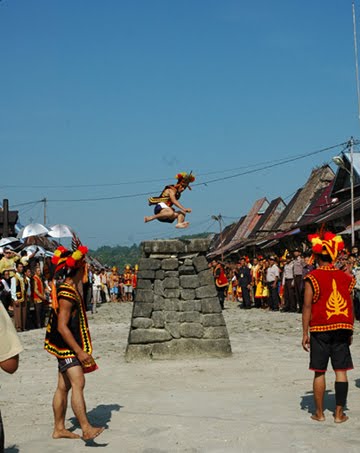THE TRADITION OF INDONESIA, HALAL BI HALAL
This is the typical tradition of Indonesian society. Halal bi halal name. This tradition is a tradition rooted in Indonesia. Hence, many Indonesian people who make it as an important momentum in the procession of life. It is not known exactly when this tradition started. But that clearly has become a typical tradition of Indonesia, well before Indonesia became more modern. And strangely, although Indonesia's modern society but this tradition seems to not be cracked by the heat and decayed by the rains. Want proof? Try to see how people in Indonesia who are overseas and away from relatives willing to coincide relatives return home only for one thing, make halal bi halal.

It was a touching scene that at the end of Ramadhan, especially in the third or fourth day before the Eid holiday they scramble to get back to their respective regions with the aim of shaking hands and saying on the day of forgiveness that the mujahidin. This is one of the beauty of the local tradition of religious-based, ie they gather once a year to forgive each other and met with relatives near and far in order to enliven the Idul Fitri holidays that always be missed.
In this modern era, could actually saying sorry to each other is through mobile phones, even through facebook, twitter and so on. But the longing to meet each other physically as well as the longing for his homeland was far more important than anything. Therefore, before the holiday all crowded public transport. Buses, trains, ships, aircraft, and full of passengers. Even private vehicles like cars and motorbikes on the crowded highway. Even sometimes they have to risk one's life. It's the holiday has great magnet for the Indonesian people to celebrate.
Islam that we know are very stressed about forgiveness. Sins to God can be requested directly to His forgiveness. But the sins of mankind should be to concerned to forgive each other. If they do not forgive each other, then that sin will not be forgiven by God. Islam as exemplified by the Prophet Muhammad is the religion of brotherly love.
This is the power of brotherhood of Islam in the building not only to fellow Muslims but also to fellow human beings. There ukhuwah Islamiyah and there ukhuwah basyariyah. There was a fellow Muslim brotherhood and sisterhood of humanity there. Such concepts are later captured by the Indonesian people to the conception and implementation of these Halal bi halal. Hence, this tradition is expected to be a unique and continue to be implemented. Onslaught of modern technology through information and communication technologies, it is also not able to eliminate this tradition. Hence, in the middle of the information technology bubble harder still found millions of people who crowded to celebrate Lebaran in his homeland.
This is the typical tradition of Indonesian society. Halal bi halal name. This tradition is a tradition rooted in Indonesia. Hence, many Indonesian people who make it as an important momentum in the procession of life. It is not known exactly when this tradition started. But that clearly has become a typical tradition of Indonesia, well before Indonesia became more modern. And strangely, although Indonesia's modern society but this tradition seems to not be cracked by the heat and decayed by the rains. Want proof? Try to see how people in Indonesia who are overseas and away from relatives willing to coincide relatives return home only for one thing, make halal bi halal.

It was a touching scene that at the end of Ramadhan, especially in the third or fourth day before the Eid holiday they scramble to get back to their respective regions with the aim of shaking hands and saying on the day of forgiveness that the mujahidin. This is one of the beauty of the local tradition of religious-based, ie they gather once a year to forgive each other and met with relatives near and far in order to enliven the Idul Fitri holidays that always be missed.
In this modern era, could actually saying sorry to each other is through mobile phones, even through facebook, twitter and so on. But the longing to meet each other physically as well as the longing for his homeland was far more important than anything. Therefore, before the holiday all crowded public transport. Buses, trains, ships, aircraft, and full of passengers. Even private vehicles like cars and motorbikes on the crowded highway. Even sometimes they have to risk one's life. It's the holiday has great magnet for the Indonesian people to celebrate.
Islam that we know are very stressed about forgiveness. Sins to God can be requested directly to His forgiveness. But the sins of mankind should be to concerned to forgive each other. If they do not forgive each other, then that sin will not be forgiven by God. Islam as exemplified by the Prophet Muhammad is the religion of brotherly love.
This is the power of brotherhood of Islam in the building not only to fellow Muslims but also to fellow human beings. There ukhuwah Islamiyah and there ukhuwah basyariyah. There was a fellow Muslim brotherhood and sisterhood of humanity there. Such concepts are later captured by the Indonesian people to the conception and implementation of these Halal bi halal. Hence, this tradition is expected to be a unique and continue to be implemented. Onslaught of modern technology through information and communication technologies, it is also not able to eliminate this tradition. Hence, in the middle of the information technology bubble harder still found millions of people who crowded to celebrate Lebaran in his homeland.
 - HALAL BI HALAL
- HALAL BI HALAL














